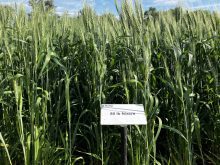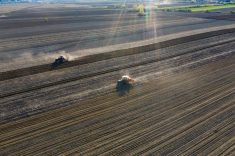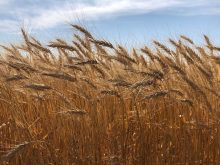Q: What factors should be considered with fall tillage following a drought?
A: Fall work might include tillage operations for fertilizer and herbicide applications. Other tillage operations might include vertical tillage for residue management and tillage to break up surface compaction. The question after a drought is, “Should I till?”
Many parts of Western Canada have received late-summer rains that make tillage decisions easier, but the benefits of leaving surface residue cannot be overlooked. The ability for soil to retain moisture is dependent on soil organic matter and soil structure — tillage operations decrease both. Surface residues increase water infiltration, maintenance of soil macrospores and a reduction of surface run-off events, thus increasing soil moisture storage.
Read Also

Claas brings 1000 Series SP forage harvesters to Canada
In mid-August, Claas unveiled its new line of Jaguar forage harvesters at an event in Visalia, California, deep in the heart of that state’s dairy region.
For areas that have not had fall moisture, the risk may outweigh the benefit. Lack of soil moisture in the top 12 inches, where most tillage occurs, can produce unfavourable conditions for soil fracturing. These conditions can produce large clods that are not easy to break with secondary tillage in the spring.
Fall applications of herbicides for resistance management have many benefits — growers may wish to consider surface applications or use products that do not require tillage.
Fall fertilizer applications generally require tillage. Nitrogen applications are the safest from loss when applied in a band three to four inches deep in the soil below residue layers. Anhydrous ammonia can be applied if the soil flows behind the shank preventing gaseous loss during application. Our soils retain enough moisture to bind the NH3 to the soil. In this case, tillage in the fall can help to maximize spring moisture for crop use by limiting moisture loss due to spring tillage.
Tillage for residue management comes at a fertility cost. Shallow incorporation of residues increases immobilization tying up nitrogen in the soil as soil microbes use nitrogen to break down the added material.
Growers must weigh the cost and benefits of each tillage operation. This will change from farm to farm and field to field as soil characteristics change. Working with a qualified agrologist can help growers weigh the risk and benefits depending on the desired outcome. Understanding your soil texture and current soil moisture conditions will aid in decision-making. Not all tillage is bad and not all tillage is good. Understanding the effects of tillage is the key when working toward a healthy soil ecosystem.
Twyla Jones, PAg, CCA, is an area manager in north-central Alberta with Nutrien Ag Solutions.















